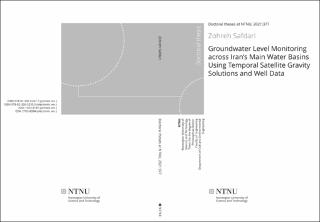| dc.description.abstract | Water is an essential resource for life on the earth; no life can exist without water. During recent decades, because of growth in population and technologies, demands for water resources have been increasing. Due to groundwater’s physical properties, it has a special role in human life especially in a dry and semi-dry climate like that in Iran. Therefore, management of sustainability of groundwater is necessary. The first stage in water management is to collect water-table data in order to have a time series of groundwater storage (GWS) changes. Nevertheless, in some areas, there is no continuous, reliable data, or access to these data requires the permission of the respective governments. Sometimes these data are outdated and measured by inconsistent methods between geopolitical boundaries and therefore are not reliable. The acquisition of accurate data is a major challenge. Globally, there are no extensive ground-based networks for monitoring largescale GWS variations.
Satellite observations from the GRACE (Gravity Recovery and Climate Experiment) mission present a new and valuable tool to fill the gaps in data availability. Standard GRACE modeling of groundwater changes are usually country-wide. These country-scale models, however, cannot be used in finer basin-scales. In this thesis, we developed a technique to move GRACE modelling from the country-scale to the sub-basin scale. We developed the GRACE least square mascon solution method for specific regions of Iran, chosen largely to coincide with main water basin.
We have used 163 months of CSR GRACE Level-2 release 6.0 data (2002 to 2017) and 15 months of GRACE Follow-On (FO) (2018 to 2019). The degree 1 coefficients are computed as described by Swenson et al. (2008). The coefficient of C20 is replaced by estimates from Satellite Laser Ranging (SLR) data. The effects of Glacial Isostatic Adjustment (GIA) are removed by subtracting the GIA Stokes coefficients computed by A et al. (2013). Instead of using a decorrelation filter, the Spherical Harmonic coefficients are smoothed using a Gaussian smoothing function with a 100-km radius. Total water storage changes are synthesized on a 0.5° spatial grid over Iran. The signal from the Caspian Sea and Urmia Lake are removed as described in Swenson and Wahr (2007). Output from a version of the CLM4.5 land surface model has been used to remove contributions from soil moisture, snow, canopy storages, and river storage. We conclude that most of the long-term water loss is due to a decline in GWS. To estimate the time series of groundwater changes using the GRACE data and its necessary corrections, a software package was developed. We have estimated total water storage trends for the whole of Iran inferred from GRACE data -20.49± 1 (GT/yr). Total water storage trends for the largest basin of Iran (central plateau basin) are -7.0 ± 4 (GT/yr).
The other part of this thesis deals with groundwater changes estimation from observation wells data. There are 17,865 active observation wells in the whole of Iran. In order to study well level time series, Iran is divided into six main basins. These six main water basins have 32 sub-basins. Each sub-basin is divided into several study areas too. TheThiessen polygon method has been used to make a time series of the groundwater level across each study area. The total changes in GWS across each sub-basin is computed by adding together the scaled change in GWS of all its study areas. The same procedure is carried out for each main water basin.
By estimating secular trend groundwater storage changes in Iran during 2002–2017, we see that there is an intensive negative trend, even -4,400 Million cubic meter (Mm3) in some areas. The largest contributions to water consumption in Iran belong to the agriculture section. These estimations show changing in climate and extra extraction from aquifers for agriculture use in some areas in Iran.
The secular trend of groundwater storage changes in the whole of Iran inferred from observation well data is -20.08 GT/yr, and inferred from GRACE data is -20.49 GT/yr. These two trends agree to a good extent. Groundwater changes estimations for each main water basin as a mascon, inferred from GRACE data and observation well data, agree to a good extent. | en_US |
